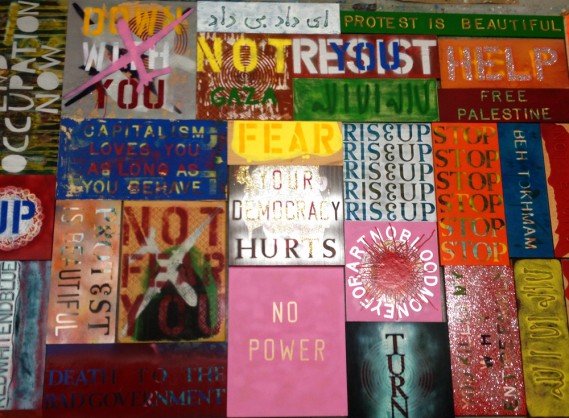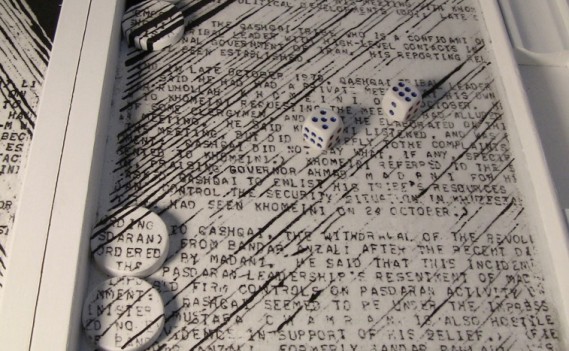Taraneh Hemami Organizes Pop-Up Bazaar Exploring Iranian Political Activism
Taraneh Hemami (2012 Awardee) premieres her Creative Capital project, Theory of Survival: Fabrications, at Southern Exposure in San Francisco, September 5–October 25, 2014. Drawing inspiration from a traditional Persian marketplace, Fabrications takes the form of a pop-up bazaar featuring work by 12 California-based Iranian artists exploring decades of collective activism and revolutionary actions inside Iran and in its larger diaspora. Within a labyrinth of niches and patterned archways designed by the H. Majd Design Group, the Fabrications bazaar is a site for gathering and exchange focused on Iranian political and cultural historical moments. Market booths overflow with handcrafted and manufactured objects; a library boasts a growing collection of publications and archives; and a teahouse becomes a stage for performances, games and storytelling.
Jenny Gill connected with Taraneh to learn more about Fabrications and her ongoing Theory of Survival project.
Jenny Gill: How do you see your role in this project? As artist, as curator, as historian—or all of the above?
Taraneh Hemami: I would add organizer, facilitator, archivist, producer as well—all part of my art practice of the last decade. I have primarily been interested in creating opportunities for creative exchange between multi-generational artists, especially of Iranian descent, to invest and decipher the layered histories we share that connect and separate us. The conversations and the exchange amongst the artists and with the audiences are at the center of the Theory of Survival project. Rather than a singular voice—one point of view—the complexity of the subject is reflected in the multiplicity of responses and impressions, reiterations and remembrances.
Jenny: Can you talk about some of the work that will be presented in the Fabrications bazaar?
Taraneh: The artists’ projects are varied in material and presentation, often reflecting a personal connection and at times investigating alternative narratives to the transcribed official accounts of the times. Artists take on actions, personas and activities that are common in a bazaar as strategies and tools of representation, presenting objects and wares in their personalized market booths, narrating often critical tales of heroism and martyrdom, or playing board-games of espionage and secrecy in the teahouse.
Azin Seraj deconstructs the very symbol of commerce and political power—the banknote—weaving together cultural iconography from before and after the Iranian Revolution to create a hybrid version of the note that highlights what has endured and what has been discarded.
A few projects look at specific Iranian Student Association (ISA) actions at and around the time of the revolution, such as the hand embroidered Tazieh flag by Amitis Motevalli that depicts a confrontation scene between ISA and the Los Angeles police at a demonstration in front of the late Shah’s sister’s Beverly Hills residence, resulting in large numbers of students arrests and injuries; or Ala Ebtekar crafting a new narration of the revolution by weaving collected radio and television footage with the revolutionary songs of the student organization to create mix-tapes with personal connections and connotations that capture the fervor and euphoria of the moment. Hushidar Mortezaie uses his father’s personal archives of his activist years to stage a critical tableaux of “dismembered and disremembered” heroes of the past.
Several of the projects take the form of apparel or wearable goods. Amir H. Fallah tie-dyes women’s black scarves and chadors to forge a connection between the sexual and freedom movement in the west and what became the symbol of the Islamic Revolution, devised as a revolt against the western objectification of women. Audiences are encouraged to try out and purchase these now acid-worn, pattern-filled fabrics. Haleh Niazmand creates a series of elegant women’s apparel that are embedded with dissident iconography borrowed from ephemera collected by her father. They highlight the irony and possibly the blasphemy in commodification of what was once revered and sacred. Using a variety of sources from news to personal photographs, Taravat Talepasand creates a unique t-shirt line that also looks at western influences on women in Iran, specifically examining the rapid growth of punk amongst Iranian youth in response to the restrictions imposed by the Islamic Republic immediately following the revolution.
There are many more projects, and there will also be a Theory of Survival souvenir shop that offers symbols of resistance and dissent drawn from the ISA archives as manufactured or hand-crafted memorabilia.
Taraneh: Connections to the local and global activist histories and stories are of special interest for my research and investigation. They have manifested as part of a timeline I have created that specially highlights these links and parallels. The timeline will be presented in the exhibition in the form of an interactive puzzle and will be published as context for the personal narratives.
Several other projects in Fabrications examine parallel and connected movements of dissent, past and present, often originating in the vibrant political scene and activist history of the Bay Area and other centers of cultural exchange where the Iranian students of yesteryear and today are centered. For example, Sanaz Mazinani connects two recent movements of dissent in Oakland and across the world in the Middle East to create a series of small protest flags to be distributed widely through the bazaar and beyond, while Morehshin Allahyari archives 2009 social media tweets and messages of the “green movement” in Iran then transfers them onto records, creating a disjointed narrative that requires the audience’s active participation to reveal its story.

Taraneh Hemami, “Patterns of Resistance” (detail)Jenny: Do you hope that this historical look at activism in Iran will shed light on more recent protests and uprisings in the Arab world and around the globe? Are there specific projects or public programs that make connections between past and current events?
We are organizing a panel with the California Institute of Integral Studies that will specifically examine the presence of history in our everyday. We’re asking, What part of history do we carry with you everyday? And looking at the web of connections that explains the ways in which our present is shaped, in policies and politics.
Jenny: How are you encouraging audience and community engagement in the exhibition?
Taraneh: There will be Saturday Bazaars every Saturday during the run on the show (September 6 – October 25, 12-6pm). Artists will be on site hawking their fabricated objects, leading workshops and discussing their work. Visitors can browse the library or bring books, materials and personal histories to share or exchange. As part of the Souvenir shop, there’s a communal table that invites audience members to craft their own projects using stencils and embroidery sets.
We’ll also have two Night Markets on Saturday, September 27 and Saturday, October 18 from 6-9pm. These evenings of marketplace activities include performances, music and readings by Bay Area artists inspired by current events and traditional bazaar and teahouse activities. Visitors can play backgammon with Gelare Khoshgozaran, participate in a performance by Ali Dadgar, listen to a DJ set of revolutionary songs by Ala Ebtekar,and see a traditional Persian Naghali storytelling performance by Arash Fayez.
I will continue to collect narratives from past and present student activists, in Iran and outside the country. Of special interest is creating an intergenerational dialogue between these two groups. Interviews and narratives will be performed by a local theater group Darvag on October 18 and compiled into a publication later this winter. There will be a number of performative sing-along sessions of revolutionary songs as part of the Saturday events, which will culminate in a performance on October 18.
Jenny: Aside from Fabrications, what other projects do you have in the works?
Taraneh: I am at the moment developing a temporary public art project as part of Kala Art Institute’s PRINT PUBLIC, a place-making project to activate San Pablo Avenue in West Berkeley. The project will be up from May through August 2015.
Video: Taraneh Hemami presents Theory of Survival at the Creative Capital Artist Retreat
Theory of Survival: Fabrications will be on view at Southern Exposure in San Francisco through October 25.




